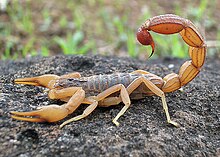Hottentotta tamulus
| Hottentotta tamulus | |
|---|---|
 |
|
| Hottentotta tamulus from Mangaon, Maharashtra, India | |
| Scientific classification | |
| Kingdom: | Animalia |
| Phylum: | Arthropoda |
| Subphylum: | Chelicerata |
| Class: | Arachnida |
| Order: | Scorpiones |
| Family: | Buthidae |
| Genus: | Hottentotta |
| Species: | H. tamulus |
| Binomial name | |
|
Hottentotta tamulus (Fabricius, 1798) |
|
| Synonyms | |
|
|
Hotentotta tamulus, the Indian red scorpion (Tamil: செந்தேள்) (also known as eastern Indian scorpion), is a species of scorpion, belonging to the family Buthidae. It occurs in most of India, eastern Pakistan and the eastern lowlands of Nepal., and recently from Sri Lanka.
This species was named Scorpio tamulus by J.C. Fabricius in 1798. The species name was apparently derived from the occurrence in the country of the Tamil people of south-eastern India. It was later often referred to the genera Buthus or Mesobuthus, although it was already correctly placed in Hottentotta by A. A. Birula in 1914, a referral that was confirmed again by F. Kovařík in 2007. Nevertheless, the binomen Mesobuthus tamulus is traditionally widespread in the popular and scientific literature. R.I. Pocock (1900) distinguished five subspecies according to coloration and distribution, but these are color-morphs (individuals with varying color) rather than subspecies.
H. tamulus specimen range in size from 50–90 mm. The coloration ranges from dark orange or brightly red-brown through dull brown with darker grey carinae (ridges) and granulation. Grey spots might be distributed irregularly across the cephalothorax and the mesosoma. The walking legs and the tip of the pedipalp pincers are brighter colored (orange-yellow to light reddish-brown). The mesosomal tergites always bear three distinct carinae. Their habitus is typical of buthid scorpions, with rather small pedipalp pincers, moderately thickened metasomal segments and a rather bulbous telson with large stinger. The base of the pedipalp pincers (manus) is slightly more inflated in males than in females.
...
Wikipedia
